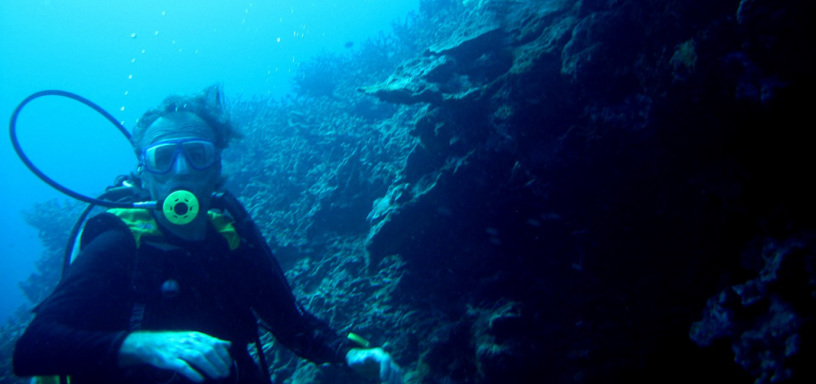Berekovens discover 19th century
shipwreck
July 12, 2011, 11:03 p.m.
IN 2005 the Bombala Times published an article on local couple, Hans and Roz Berekoven who were selling their merino flock, leasing their property and setting off to search the Java Sea for signs of lost civilisations.
At the time wool production, the farm stay and winery at “Kangaroo Camp” were greatly successful, and many were surprised at the decision to trade it all in for an adventure at sea, but they were wished well as they headed for Bali.
Since then Hans has not only been encouraged in his efforts to confirm his theory that the Sunda Shelf was once the seat of a great civilization, but the couple have also discovered and become involved in so much more.
Hanz and Roz are back in the area for a short time this month, and they certainly have some tales to tell.
Searching for World War II ships off the coast of Borneo, investigating the discovery of ancient stone coffins in Bali, and winning yacht races in their expedition vessel is just the tip of the iceberg!
Indeed Hans and Roz are now involved in documentary making and have even been approached to star in a reality television show focussing on their biggest discovery yet, a 19th century shipwreck near Borneo.
The couple are still involved in retrieving artefacts from the Viscount Melbourne wreck, and brought a few of the 150 year old bottles found in the ship to show us at the Bombala Times.
To give our readers an idea of the significance of the find, we reprint below an article by Feng Zengkun from the Straits Times in Indonesia outlining the discovery -
“A ship that sank more than 150 years ago in Borneo waters after visiting Singapore has been found by two Australians.
Part-time marine archaeologists Hans and Roz Berekoven - who are married to each other - said their find was unlikely to yield any treasures as the ship had been a British cargo vessel, but it could add to knowledge of trade then.
‘No gold,’ Mr Berekoven, 64, said in an interview in Singapore. ‘Just cutlery and a few bottles of really well-aged wine.’
In 1842, the Viscount Melbourne sailed from India en route to China and docked in Singapore to pick up supplies and passengers. It left with more than 70 people on board.
Three days after it left Singapore, the vessel was hit by a squall. It was left stranded on a coral reef.
The ship had to be abandoned as the cotton bales it carried would expand when wet.
One survivor wrote in his diary that the bales would ‘swell and inevitably blow up the ship’.
The crew and passengers, evacuated in boats, spent weeks at sea before reaching nearby Borneo. Their journey was fraught with dangers such as bad weather and encounters with pirates.
Britain even sent a second ship, the Royalist, to look for the survivors. The Viscount Melbourne was left on the reef since it carried nothing of value. It eventually sank.
Newspapers in the region reported on its loss at the time but interest faded and the wreck was abandoned to its fate.
Then in 1950, The Straits Times published a series of articles on the survivors’ struggle to reach Borneo. The series, titled ‘A perilous sea voyage’, gave the Berekovens the key to finding the wreck.
The couple had seen vague references to the wreck and its survivors while researching another project.
An Internet search led to excerpts of The Straits Times articles, which in turn led them to the National Library in Singapore, where the full articles were kept.
‘We spent five days in the archives working out the route the survivors took,’ Mr Berekoven said. ‘The diarist kept an incredibly detailed log.’
Tracing the route backwards, they were able to find the wreck within 25 minutes of dropping anchor. ‘There was no cotton left of course,’ Mrs Berekoven, 53, said. ‘When we saw that the hull had burst outwards, we knew what had happened.’
That was in April last year. Since then, the Berekovens have revisited the wreck several more times, each time bringing up small artefacts such as spoons and bottles of preserved fruit.
The bad weather that had befallen the ship remains to this day, preventing more frequent visits, the couple said.
The depth of the wreck at 40m underwater and the limitations of their equipment mean they can spend only nine minutes at a time on the ship before they have to resurface.
‘We’re saving up for better equipment like scuba gear,’ Mr Berekoven said.
Their salvage project is partially funded by Chinese Malaysian businessman Troy Yaw, whose father Yaw Teck Seng is one of Malaysia’s 40 richest people.
The Berekovens said artefacts from the ship will go to a maritime museum about the region that the younger Mr Yaw intends to set up.
The couple’s own goal is to make a documentary about the survivors.
Mrs Berekoven said: ‘It’ll make a great story. The ship was named after the Prime Minister of England then. It had a woman on board with a baby and a two-year-old boy, and what they went through in the open waters already reads like a movie script.’
The boy, George Mildmay Dare, also returned to Singapore and became a local celebrity in his time, Mr Berekoven added. Mr Dare was the first person to be buried in the old Bidadari cemetery.
The archaeologist said: ‘The ship came here, it disappeared, and it was eventually ‘found’ again in the National Library here. Its story is part of local history.’”
(Reprinted courtesy of Straits Times Indonesia)
As mentioned, this is just one archaeological project in which the Berekovens are involved, with those who would like to learn more being encouraged to check out www.southernsun.info/ or simply Google Hans Berekoven.
It’s worth taking a look at the fascinating lives these former locals are living!
At the time wool production, the farm stay and winery at “Kangaroo Camp” were greatly successful, and many were surprised at the decision to trade it all in for an adventure at sea, but they were wished well as they headed for Bali.
Since then Hans has not only been encouraged in his efforts to confirm his theory that the Sunda Shelf was once the seat of a great civilization, but the couple have also discovered and become involved in so much more.
Hanz and Roz are back in the area for a short time this month, and they certainly have some tales to tell.
Searching for World War II ships off the coast of Borneo, investigating the discovery of ancient stone coffins in Bali, and winning yacht races in their expedition vessel is just the tip of the iceberg!
Indeed Hans and Roz are now involved in documentary making and have even been approached to star in a reality television show focussing on their biggest discovery yet, a 19th century shipwreck near Borneo.
The couple are still involved in retrieving artefacts from the Viscount Melbourne wreck, and brought a few of the 150 year old bottles found in the ship to show us at the Bombala Times.
To give our readers an idea of the significance of the find, we reprint below an article by Feng Zengkun from the Straits Times in Indonesia outlining the discovery -
“A ship that sank more than 150 years ago in Borneo waters after visiting Singapore has been found by two Australians.
Part-time marine archaeologists Hans and Roz Berekoven - who are married to each other - said their find was unlikely to yield any treasures as the ship had been a British cargo vessel, but it could add to knowledge of trade then.
‘No gold,’ Mr Berekoven, 64, said in an interview in Singapore. ‘Just cutlery and a few bottles of really well-aged wine.’
In 1842, the Viscount Melbourne sailed from India en route to China and docked in Singapore to pick up supplies and passengers. It left with more than 70 people on board.
Three days after it left Singapore, the vessel was hit by a squall. It was left stranded on a coral reef.
The ship had to be abandoned as the cotton bales it carried would expand when wet.
One survivor wrote in his diary that the bales would ‘swell and inevitably blow up the ship’.
The crew and passengers, evacuated in boats, spent weeks at sea before reaching nearby Borneo. Their journey was fraught with dangers such as bad weather and encounters with pirates.
Britain even sent a second ship, the Royalist, to look for the survivors. The Viscount Melbourne was left on the reef since it carried nothing of value. It eventually sank.
Newspapers in the region reported on its loss at the time but interest faded and the wreck was abandoned to its fate.
Then in 1950, The Straits Times published a series of articles on the survivors’ struggle to reach Borneo. The series, titled ‘A perilous sea voyage’, gave the Berekovens the key to finding the wreck.
The couple had seen vague references to the wreck and its survivors while researching another project.
An Internet search led to excerpts of The Straits Times articles, which in turn led them to the National Library in Singapore, where the full articles were kept.
‘We spent five days in the archives working out the route the survivors took,’ Mr Berekoven said. ‘The diarist kept an incredibly detailed log.’
Tracing the route backwards, they were able to find the wreck within 25 minutes of dropping anchor. ‘There was no cotton left of course,’ Mrs Berekoven, 53, said. ‘When we saw that the hull had burst outwards, we knew what had happened.’
That was in April last year. Since then, the Berekovens have revisited the wreck several more times, each time bringing up small artefacts such as spoons and bottles of preserved fruit.
The bad weather that had befallen the ship remains to this day, preventing more frequent visits, the couple said.
The depth of the wreck at 40m underwater and the limitations of their equipment mean they can spend only nine minutes at a time on the ship before they have to resurface.
‘We’re saving up for better equipment like scuba gear,’ Mr Berekoven said.
Their salvage project is partially funded by Chinese Malaysian businessman Troy Yaw, whose father Yaw Teck Seng is one of Malaysia’s 40 richest people.
The Berekovens said artefacts from the ship will go to a maritime museum about the region that the younger Mr Yaw intends to set up.
The couple’s own goal is to make a documentary about the survivors.
Mrs Berekoven said: ‘It’ll make a great story. The ship was named after the Prime Minister of England then. It had a woman on board with a baby and a two-year-old boy, and what they went through in the open waters already reads like a movie script.’
The boy, George Mildmay Dare, also returned to Singapore and became a local celebrity in his time, Mr Berekoven added. Mr Dare was the first person to be buried in the old Bidadari cemetery.
The archaeologist said: ‘The ship came here, it disappeared, and it was eventually ‘found’ again in the National Library here. Its story is part of local history.’”
(Reprinted courtesy of Straits Times Indonesia)
As mentioned, this is just one archaeological project in which the Berekovens are involved, with those who would like to learn more being encouraged to check out www.southernsun.info/ or simply Google Hans Berekoven.
It’s worth taking a look at the fascinating lives these former locals are living!


